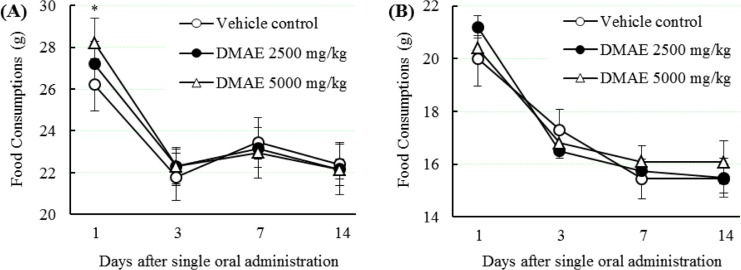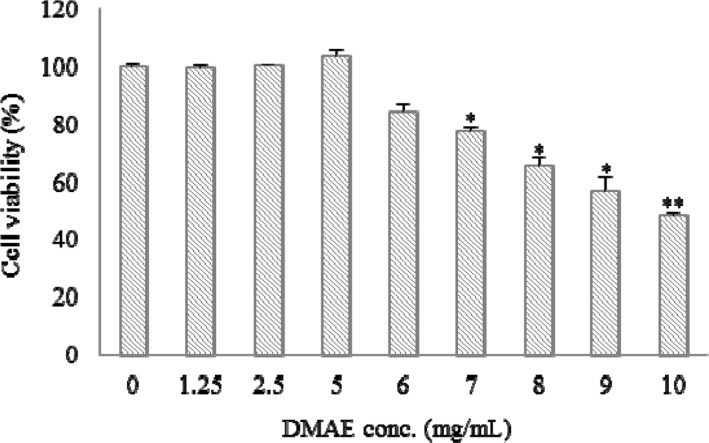Lab Anim Res.
2016 Sep;32(3):144-150. 10.5625/lar.2016.32.3.144.
Acute toxicity and cytotoxicity evaluation of Dendrobium moniliforme aqueous extract in vivo and in vitro
- Affiliations
-
- 1Division of Tradition Korean Medicine Research, National Development Institute of Korean Medicine, Jangheung, Korea. i0823@nate.com
- 2College of Veterinary Medicine, Chonnam National University, Gwangju, Korea. toxkim@jnu.ac.kr
- KMID: 2353589
- DOI: http://doi.org/10.5625/lar.2016.32.3.144
Abstract
- Dendrobium moniliforme (L.) Sw., an herb of the Orchidaceae family, has long been used in traditional medicine to strengthen bones, nourish the stomach, and promote the production of bodily fluid. Recently, polysaccharides isolated from Dendrobium have been used in functional foods and nutraceutical products. A traditional method to process Dendrobium is to soak fresh stems in an ethanol solution, which is the most important factor to ensure high yields of aqueous-extractable polysaccharides. The present study was carried out to investigate the potential acute toxicity of D. moniliforme aqueous extract (DMAE), by a single oral dose in Sprague-Dawley rats. The test article was orally administered once by gavage to male and female rats at doses of 0, 2,500, and 5,000 mg/kg body weight (n=5 male and female rats for each dose). Throughout the study period, no treatment-related deaths were observed and no adverse effects were noted in clinical signs, body weight, food consumption, serum biochemistry, organ weight, or gross findings at any dose tested. The results show that a single oral administration of DMAE did not induce any toxic effects at a dose below 5,000 mg/kg in rats, and the minimal lethal dose was considered to be over 5,000 mg/kg body weight for both sexes. With respect to cytotoxicity, the cell viability of human embryonic kidney (HEK293) cells was less than 50% when the cells were treated with 10 mg/mL aqueous extract for 24 h.
MeSH Terms
Figure
Reference
-
1. Firenzuoli F, Gori L. Herbal medicine today: clinical and research issues. Evid Based Complement Alternat Med. 2007; 4(S1):37–40. PMID: 18227931.
Article2. Jordan SA, Cunningham DG, Marles RJ. Assessment of herbal medicinal products: challenges, and opportunities to increase the knowledge base for safety assessment. Toxicol Appl Pharmacol. 2010; 243(2):198–216. PMID: 20018204.
Article3. Puchooa D. Comparison of different culture media for the in vitro culture of Dendrobium (Orchidaceae). Int J Agric Biol. 2004; 6:884–888.4. Garay LA, Sweet HR. Orchids of Southern Ryukyu Islands. Cambridge: Botanical Museum, Harvard University;1974. p. 180.5. Pearce NR, Cribb PJ. The Orchids of Bhutan. Huddersfield, United Kingdom: Charlesworth Group;2002. p. 195–212.6. Tsi ZH. Tsi ZH, editor. Flora Reipublicae Popularis Sinicae Tomus. vol. 19. Beijing: Sciences Press;1999. p. 339–420.7. Xing X, Cui SW, Nie S, Phillips GO, Goff HD, Wang Q. A review of isolation process, structural characteristics, and bioactivities of water-soluble polysaccharides from Dendrobium plants. Bioact Carbohyd Diet Fibre. 2013; 1:131–147.8. Wang Q, Gong Q, Wu Q, Shi J. Neuroprotective effects of Dendrobium alkaloids on rat cortical neurons injured by oxygenglucose deprivation and reperfusion. Phytomedicine. 2010; 17(2):108–115. PMID: 19577451.
Article9. Bao X, Shun Q, Chen L. The Medicinal Plants of Dendrobium (Shi-Hu) in China. A Coloured Atlas. Shanghai: Press of Fudan University and Press of Shanghai Medical University;2001.10. Li NY, Gao PY, Wang Z. Determination of polysaccharide and amino acid contents in some species of Dendrobium and Flickingeria. J Plant Resour Environ. 2004; 13(4):57–58.11. Xu C, Chen YL, Zhang M. Structural characterization of the polysaccharide DMP2a-1 from Dendrobium moniliforme. Chinese Pharmaceut J. 2004; 39:900–902.12. Chen ZH, Chen YL, Wu T, Hua YF, Zhang M. Study on structural characteristics and immunomodulatory activity of polysaccharide DMP4a-1 from Dendrobi-um moniliforme. Chinese Pharmaceut J. 2005; 40:1781–1784.13. Hsieh YS, Chien C, Liao SK, Liao SF, Hung WT, Yang WB, Lin CC, Cheng TJ, Chang CC, Fang JM, Wong CH. Structure and bioactivity of the polysaccharides in medicinal plant Dendrobium huoshanense. Bioorg Med Chem. 2008; 16(11):6054–6068. PMID: 18467102.
Article14. Huang MQ, Ruan JY. Monosaccharide composition analysis of 6 water-soluble polysaccharides from Dendrobium species. Zhongguo Zhong Yao Za Zhi. 1997; 22:77–115. PMID: 10743196.15. Fan Y, He X, Zhou S, Luo A, He T, Chun Z. Composition analysis and antioxidant activity of polysaccharide from Dendrobium denneanum. Int J Biol Macromol. 2009; 45(2):169–173. PMID: 19414030.
Article16. Wang JH, Luo JP, Zha XQ, Feng BJ. Comparison of antitumor activities of different polysaccharide fractions from the stems of Dendrobium nobile Lindl. Carbohydr Polym. 2010; 79:114–118.17. Qu WL, Liu HL, Shang ZY. Systematic philological research on the development of Dendrobium in traditional chinese medicine. Asia-Pacific Tradit Med. 2011; 7:133–134.18. Chen ZR, Lai PF, Lin Q. Effects of different herbal processing methods on levels of water-extractable Dendrobium alkaloids and polysaccharides. J Zhejiang Coll Tradit Chinese Med. 2002; 26:79–81.19. Korea Food and Drug Administration. Testing Guidelines for Safety Evaluation of Drugs. Cheongju: KFDA;2014.20. OECD. Guidelines for Testing of Chemicals. Guideline 423. Acute Oral Toxicity-Acute Toxic Class Method. Paris: Organisation for Economic Co-operation and Development;2001.21. NRC (National Research Council). Guide for the Care and Use of Laboratory Animals. National Academy, Washington, USA: National Research Council;1996.22. Wang XK, Zhao TF. A discussion of the chemical constituents of Dendrobium plants and of the Chinese herbal drug Shi-Hu. Int J Orient Med. 1990; 15:146–155.23. Wu SJ, Liu YS, Chen TW, Ng CC, Tzeng WS, Shyu YT. Differentiation of Medicinal Dendrobium Species (Orchidaceae) Using Molecular Markers and Scanning Electron Microscopy. J Food Drug Anal. 2009; 17:474–488.
Article24. Han ZZ, Xu HD, Kim KH, Ahn TH, Bae JS, Lee JY, Gil KH, Lee JY, Woo SJ, Yoo HJ, Lee HK, Kim KH, Park CK, Zhang HS, Song SW. Reference Data of the Main Physiological Parameters in Control Sprague-Dawley Rats from Pre-clinical Toxicity Studies. Lab Anim Res. 2010; 26(2):153–164.
Article25. Lee JM, Lee MA, Do HN, Song YI, Bae RJ, Lee HY, Park SH, Kang JS, Kang JK. Historical control data from 13-week repeated toxicity studies in Crj:CD (SD) rats. Lab Anim Res. 2012; 28(2):115–121. PMID: 22787485.
Article26. Petterino C, Argentino-Storino A. Clinical chemistry and haematology historical data in control Sprague-Dawley rats from pre-clinical toxicity studies. Exp Toxicol Pathol. 2006; 57(3):213–219. PMID: 16343876.
Article27. Luo JP, Deng YY, Zha XQ. Mechanism of Polysaccharides from Dendrobium huoshanense. on Streptozotocin-Induced Diabetic Cataract. Pharmaceut Biol. 2008; 46:243–249.28. Lv GY, Xia CQ, Chen SH, Su J, Liu XP, Li B, Gao JL. Effect of Dendrobium officinale granule on long-term-alcohol-induced hypertension rats. Zhongguo Zhong Yao Za Zhi. 2013; 38(20):3560–3565. PMID: 24490573.29. Jiang MD. Study on a natural health drink: Dendrobium nobile juice. J Zhejiang Agricultural University;1997. p. S1.30. Fu Y, Mei S, Liu DY, Lai WQ, Chen JG, Wang Y. A toxicological security study of dendrobium candidum capsule. Chinese J Health Lab Technol. 2010; 11:045.31. Prasad R, Koch B. Antitumor activity of ethanolic extract of Dendrobium formosum in T-cell lymphoma: an in vitro and in vivo study. Biomed Res Int. 2014; 2014:753451. PMID: 24959588.
- Full Text Links
- Actions
-
Cited
- CITED
-
- Close
- Share
- Similar articles
-
- Evaluation of Acute and Sub-acute Oral Toxicity Effect of Aquilaria malaccensis Leaves Aqueous Extract in Male ICR Mice
- Evaluation of the Cytotoxicity of Polyetherurethane (PU) Film Containing Zinc Diethyldithiocarbamate (ZDEC) on Various Cell Lines
- Multilayered Cell Sheets of Cardiac Reprogrammed Cells for the Evaluation of Drug Cytotoxicity
- Antitumor effect of Ganoderma lucidum: Cytotoxicity and Tumor Growth Delay(1)
- Cytotoxic Effect of X-irradiation of Mouse Tumor Cells in the Presence of Korean Ginseng Extract



